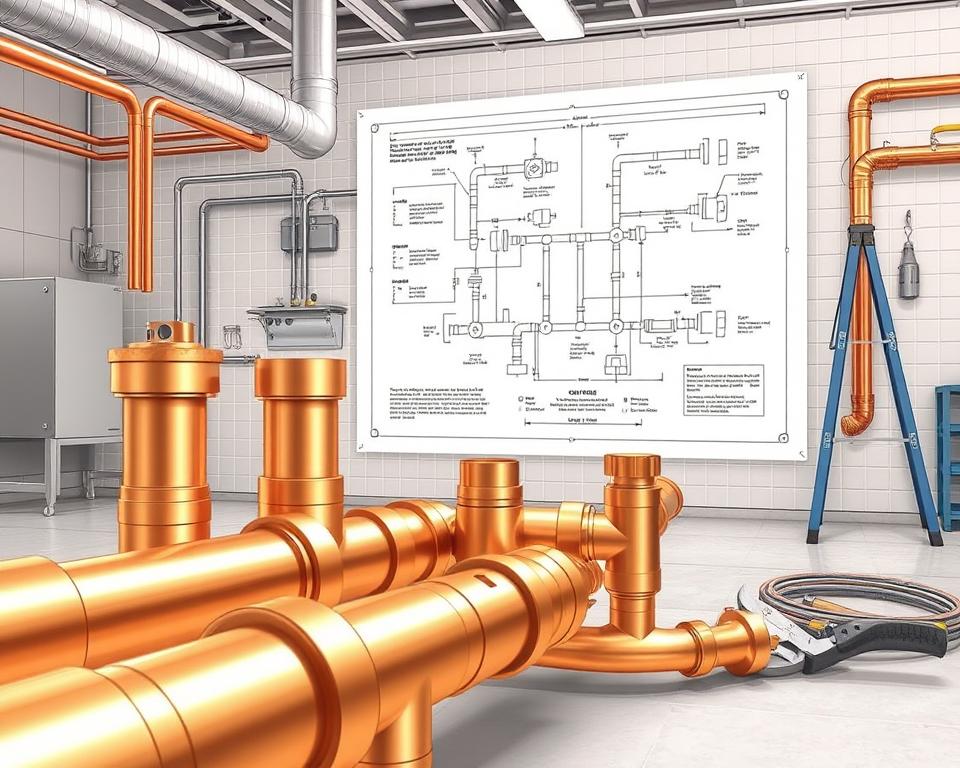Copper Gas Line Fitting & Safety Manual
Did you know about 90% of hardware stores offer to cut and thread black iron tube at a supplementary cost? This fact shows the strong demand and easy access to gas piping materials, especially copper gas lines. Many homes now favor copper for its durability, reliability, and corrosion resistance. This guide will discuss the essentials of copper gas lines, their merits, and essential safety protocols for installation. With insights from Installation Parts Supply, you’ll discover key elements of gas line installation. This information guarantees both safety and compliance while satisfying your gas piping specifications.
Summary Points
- Copper gas lines deliver longevity and rust resistance.
- Fitting demands accurate dimensions and following local code regulations.
- Protective steps are essential to secure leak-proof gas lines.
- Grasping the accurate routing and placement is essential for effective installation.
- Periodic servicing helps in prolonging the durability of copper gas lines.
Grasping the Fundamentals of Copper Gas Lines
Copper gas lines are widely used in both residential and business settings. They’re appreciated for safety and dependability. Studying 5/8 water line, including their advantages and how they stack up against other materials, is crucial. This understanding enables residents to decide wisely.
What is a Copper Gas Line?
A copper gas line uses copper piping for natural gas and propane distribution. It complies with established regulations like the National Fuel Gas Code (NFPA 54/ANSI Z223.1). In regions like Minnesota and Florida, it ranks as the leading option in home fuel gas piping. Starting in 1999, agencies such as IAPMO have endorsed its use in fuel gas systems.
Merits of Utilizing Copper Gas Lines
Copper gas lines offer several key benefits. They include:
- Corrosion Resistance: Copper excels over steel and black iron in combating corrosion.
- Flexibility: Its flexibility eases setup, even in complicated arrangements.
- Durability: Copper gas lines boast longevity and sound build, needing fewer replacements.
- Safety: Complying with rigorous guidelines, copper tubing is considered secure for gas distribution.
Comparison with Other Materials
In comparing copper and steel for gas lines, copper often wins out. Black iron pipes are still prevalent, especially in cities like Chicago. Even so, copper’s reduced weight and handling ease have increased its usage. Although roughly 50% of gas companies have switched to stainless steel owing to regulations, copper’s advantages hold strong in particular scenarios. This is especially true in areas like St. Louis, where recently built houses frequently incorporate copper gas lines.
| Required Materials | Tools for Copper Gas Line Installation |
|---|---|
| Copper tubing (Type K and Type L) | Wrench tools |
| Adapters and joints | Copper cutting tool |
| Plumber’s tape | Soldering kit |
| Protective equipment (gloves, goggles) | Pressure meter |
Best Practices for Copper Gas Line Installation
Installing copper gas lines entails specific best practices to ensure protection and productivity. Key aspects of the process comprise accurate planning of routes, secure connections, and comprehensive leak testing. These steps ensure a gas piping system that is both secure and code-compliant.
Placement and Routing for Copper Gas Lines
Thoughtful planning is crucial when placing copper gas lines. It is necessary to keep these lines separated from architectural components that might result in damage. Such an approach avoids electrochemical corrosion by avoiding contact with different metals. Also, ensuring readily accessible routes for future maintenance and repairs is required by maintaining clearances.
Adhering to these routing and positioning guidelines enhances the system’s safety and durability.
Connecting and Sealing Pipes Properly
Making secure connections in copper gas pipes necessitates particular supplies. Employ gas-grade plumber’s tape and gas-specific sealants exclusively. Refrain from regular thread seal tape to avoid leaks from thread oils. By adhering to proper attachment and sealing methods, the chance of gas leaks is markedly diminished, aligning with safety and regulatory requirements.
Testing for Leaks Post-Installation
Post-installation, performing an exhaustive leak inspection is vital. Begin with a pressure test, applying 1.5 times the system’s peak operating pressure for at least 10 minutes. Alternatively, you may use a soapy water solution to reveal leaks through the formation of bubbles. The desired pressure for these tests should be around 9 inches w.c., with a minor deviation permitted. These methods of leak detection are fundamental in ensuring the safety of the gas system, which secures both assets and lives.
Copper Gas Line Code Requirements
Understanding and adhering to the multiple standards and codes is crucial for copper gas line safety. These regulations ensure compliance and reduce risks such as leaks and failures. Both residents and professionals need to strictly adhere to local building codes. They are required to secure the required permits before initiating any projects.
Understanding Local Code Requirements
Local building codes dictate the standards for fitting copper gas lines. They address issues like installation depth, needed support structures, and corrosion prevention measures. For underground pipes, there is usually a requirement for 18 inches of cover. However, in some situations, this can be reduced to 12 inches. Metal sleeves are also commonly mandated for copper tubing that passes through wall plates near open edges.
Inspection and Compliance
Regular inspections by certified professionals are essential for gas line safety. They verify that installations comply with both the National Fuel Gas Code and local building codes. These evaluations check whether copper pipes are firmly installed and if holes drilled through joists are the correct size. Adhering to these criteria improves safety and ensures reliable operation of gas line installations over time.
Tackling Frequently Encountered Issues in Copper Gas Lines
Copper gas lines, renowned for their longevity, can experience corrosion problems. It’s crucial to understand possible issues and essential maintenance to guarantee safety. Recognizing corrosion signs and the advantages of upkeep can avert gas leaks. This knowledge alongside comparing copper to steel gas lines helps decide the best material use.
Copper Gas Line Corrosion Issues
Over time, copper gas lines may deteriorate due to environmental influences or setup mistakes. Warning indicators include color changes, flaking, and unexpected gas bill hikes. Such damage can cause gas leaks, as evidenced by a sulfur odor from added mercaptan. After construction or excavation, checking for visible damage is crucial.
Upkeeping Your Copper Gas Line
For security and performance, upkeeping copper gas lines is critical. Yearly checks can identify initial signs of corrosion and problems. Keeping appliances clean and well-ventilated prevents gas buildup and carbon monoxide dangers. Only licensed technicians should manage repairs and installations, ensuring safety code compliance and minimizing risks of failure.
Comparing Copper Gas Lines to Steel: Advantages and Disadvantages
Deciding between copper and steel gas lines involves weighing pros and cons. Copper’s malleability eases installation in tight spaces and typically offers better corrosion resistance. In comparison, steel lines may offer greater longevity and cost less for some projects. Understanding these factors helps in selecting the optimal material.
In Summary
The necessity of adhering to optimal methods for copper gas line installation is of utmost importance. Adherence to safety standards and local codes guarantees efficiency and safety. The guide also emphasizes copper gas lines’ advantages, such as durability and corrosion resistance. However, it’s vital to keep abreast of material-related trends.
Maintenance is critical to the durability and performance of copper gas lines. Correct setup and routine evaluations mitigate risks of corrosion and operational failures. Staying updated on local code revisions is crucial to prevent penalties or expensive fixes for non-compliance.
Opt for expert consultation for copper gas installation projects as it is greatly beneficial. Installation Parts Supply supplies comprehensive expertise and assistance. They guarantee your project meets all safety requirements, improving your system’s safety and reliability.
FAQ
How would you define a copper gas line?
A copper gas line is a type of piping for gas distribution. It’s made from copper. This substance is chosen for its longevity, malleability, and corrosion resistance. These attributes make it ideal for residential gas installations.
What are the benefits of using copper gas lines?
Copper gas lines offer superior corrosion resistance and flexibility. They are easier to install than other materials. Their long lifespan and safety features make them optimal for gas distribution systems.
How do copper gas lines compare to steel or black iron pipes?
Copper gas lines outperform steel and black iron pipes in several ways. They are more resistant to corrosion and are lighter and simpler to work with. Due to these benefits, they are less prone to leakage, making them a preferred choice for many experts.
What steps should be taken prior to installing a copper gas line?
Before installing, you need to obtain local permits and grasp gas flow dynamics. Careful planning guarantees a safe and code-compliant installation.
What tools and materials are required for installing copper gas lines?
You’ll need copper pipes, connectors and fittings, and plumber’s tape. Wrenches for pipes, safety gear, and gas-grade sealants are also vital. These supplies ensure secure connections.
How should copper gas lines be routed and positioned for optimal performance?
Ensure that they avoid structural elements and dissimilar metals. Proper support structures are essential to avoid galvanic corrosion.
What is the correct method to connect and seal copper gas pipes?
Securely connect and seal pipes using gas-grade plumber’s tape and sealants. Always verify your work to avoid leakage.
What methods can be used to detect leaks post-installation of copper gas lines?
Perform leak inspections with a soapy water solution, observing for bubble formation. Applying pressure tests helps ensure the system’s integrity.
What are the key safety regulations for copper gas line installation?
Adhere to local building codes, ensure proper installation depth, and secure the necessary permits. Professional inspections are also mandatory.
What are the common corrosion issues associated with copper gas lines?
Corrosion can occur from contact with different metals or environmental factors. Avoid this by using proper setup techniques and conducting routine upkeep.
What is the best way to upkeep a copper gas line?
Maintain your lines with regular inspections, cleaning, and upkeep. This averts corrosion and leaks, promoting a long lifespan.
Under what conditions is a copper gas line preferable to steel?
Choose copper for residential use due to its flexibility and low corrosion risk. Steel is more appropriate for high-pressure, industrial settings.


